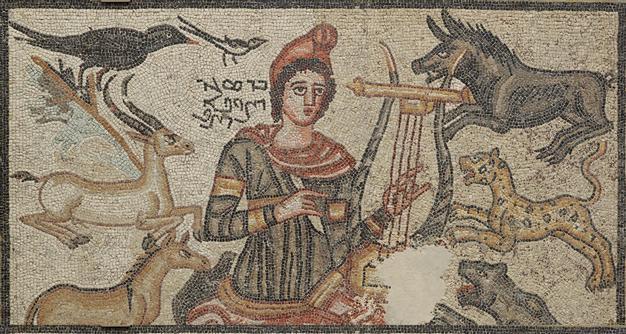Minister presents Orpheus after its return to country
ISTANBUL - Hürriyet Daily News

Turkish Culture and Tourism Minister Ertuğrul Günay says the mosaic will move to the Şanşıurfa Museum some time later. AA photo
Turkish Culture and Tourism Minister Ertuğrul Günay introduced a ceramic mosaic from the mythic poet Orpheus that was brought back to Tureky from the Dallas Museum of Art and unveiled to the media at a ceremony in Istanbul on Dec. 8.The Dallas Museum of Art returned the Orpheus Mosaic to Turkey after learning the piece was likely looted from an archaeological site in Turkey after a memorandum of understanding was signed between Turkish officials and the Dallas Museum of Art.
The mosaic would be displayed at the Istanbul Archaeology Museums for some time before later moving to the Şanlıurfa Museum, where it belongs, Günay said. “We try to bring back whatever we have outside the country. There are new pieces that we pursue,” he said.
At an unveiling ceremony held at the Istanbul Archaeology Museum, Günay said the ministry’s recent works to return Turkish artifacts to the country have drawn big interest from members of the press and the public, which made him very pleased.
As sensitivity toward the cause increases, the process will be accelerated, Günay said, adding that the return of the Boğazköy Sphinx, which was taken out of the country 90 years ago, was the first big event that aroused the public’s interest. The top half of the Hercules statue that Prime Minister Recep Tayyip Erdoğan brought from the United States on his plane then further increased interest.
Günay said that later on the İznik tiles and Troy treasures were returned to the country. “We have also received the decision to return the winged horse brooch, which was stolen from the Uşal Museum. I hope that we will see its return all together again,” he said
Director determines the mosaic
Speaking about the Orpheus Mosaic, the minister said the mosaic was taken from the eastern province of Şanlıurfa in 1998 and Turkey attempted to intervene for its return at an auction in 1999. Günsay said the director of the Dallas Museum had determined such a piece in their inventory and began searching it.
The Şanlıurfa Chief Public Prosecutor’s Office put great effort into facilitating the return of the artifact, which was returned with only a small deformation and the restoration work was almost perfect, according to Günay. The mosaic showed how beautiful people had decorated their houses in the past, Günay said. He also said that the work was different as it did not have the name of its creator on it.
“The piece is being entrusted to the Istanbul Archaeology Museum for now. When the Şanlıurfa Museum opens, the mosaic will go where it belongs to,” he said.
Nearly 4,000 pieces of art were returned to Turkey within the last five years, Günay said. “Our efforts have accelerated this process, because this figure was about 1,000 four to five years ago. Between 2002 and 2012, Turkey got 4,113 artifacts back, and 3,697 out of them are the ones returned to the country after 2007,” Günay said.
In a ceremony on Dec. 3 in Dallas, museum officials returned the Orpheus Mosaic and announced the creation of a new international exchange for collaborations for loaning artwork and sharing cultural expertise, Reuters has reported. Turkey has signed on as the museum’s first partner in the Dallas Museum Exchange program. “As arts organizations in the United States and around the world address questions regarding cultural heritage, I have long believed there is a crucial opportunity to shift the terms of these cultural discussions from an adversarial to a collaborative approach,” the museum’s director Maxwell Anderson said in a statement.
The Orpheus Mosaic, dated to A.D. 194, is known as the earliest Edessa mosaic that archaeologists have dated so far. Edessa is the Hellenistic name given to Şanlıurfa. The mosaic was taken abroad by smugglers after its discovery by J.B. Segal in 1950 in Şanlıurfa. Turkey’s Aktüel Arkeoloji magazine earlier this year launched a campaign to return the Orpheus Mosaic back to Turkey.
The mosaic depicts the mythic poet Orpheus calming wild animals by playing his lyre.
















